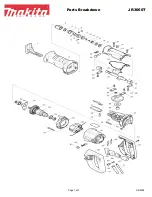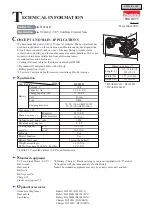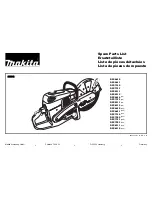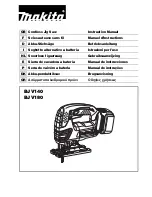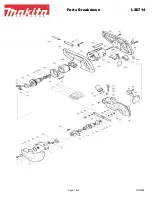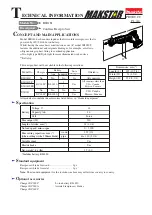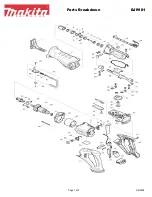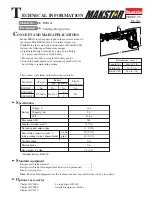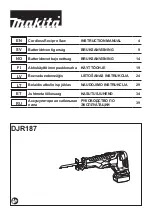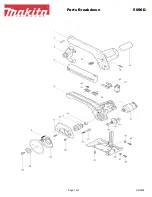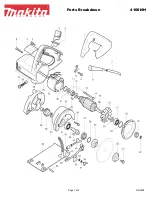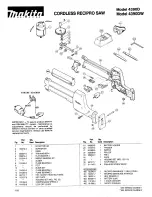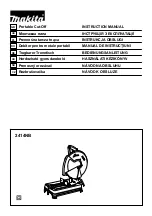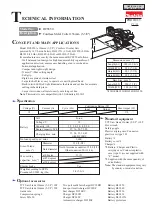
10
power tool while you are tired or under the influence of
drugs, alcohol or medication . A moment of inattention
while operating power tools may result in serious per-
sonal injury .
11 . Use personal protective equipment . Always wear
eye protection . Protective equipment such as dust mask,
non-skid safety shoes, hard hat, or hearing protection
used for appropriate conditions will reduce personal
injuries .
12 . Prevent unintentional starting . Ensure the switch is in
the off-position before connecting to power source and/
or battery pack, picking up or carrying the tool . Carrying
power tools with your finger on the switch or energising
power tools that have the switch on invites accidents .
13 . Remove any adjusting key or wrench before turning
the power tool on . A wrench or a key left attached to a
rotating part of the power tool may result in personal
injury .
14 . Do not overreach . Keep proper footing and balance
at all times . This enables better control of the power tool
in unexpected situations .
15 . Dress properly . Do not wear loose clothing or jew-
ellery . Keep your hair, clothing and gloves away from
moving parts . Loose clothes, jewellery or long hair can
be caught in moving parts .
16 . If devices are provided for the connection of dust
extraction and collection facilities, ensure these are con-
nected and properly used . Use of dust collection can re-
duce dust-related hazards .
17 . Do not force the power tool . Use the correct power
tool for your application . The correct power tool will do
the job better and safer at the rate for which it was de-
signed .
18 . Do not use the power tool if the switch does not turn
it on and off . Any power tool that cannot be controlled
with the switch is dangerous and must be repaired .
19 . Disconnect the plug from the power source and/
or the battery pack from the power tool before making
any adjustments, changing accessories, or storing power
tools . Such preventive safety measures reduce the risk of
starting the power tool accidentally .
20 . Store idle power tools out of the reach of children
and do not allow persons unfamiliar with the power tool
or these instructions to operate the power tool . Power
tools are dangerous in the hands of untrained users .
21 . Maintain power tools . Check for misalignment or
binding of moving parts, breakage of parts and any oth-
er condition that may affect the power tool’s operation .
If damaged, have the power tool repaired before use .
Many accidents are caused by poorly maintained power
tools .
22 . Keep cutting tools sharp and clean . Properly main-
tained cutting tools with sharp cutting edges are less
likely to bind and are easier to control .
23 . Use the power tool, accessories and tool bits etc . in
accordance with these instructions, taking into account
the working conditions and the work to be performed .
Use of the power tool for operations different from those
intended could result in a hazardous situation .
BATTERY TOOL USE AND CARE
• Recharge only with the charger specified by the manu-
facturer . A charger that is suitable for one type of battery
pack may create a risk of fire when used with another
battery pack .
• Use power tools only with specifically designated bat-
tery packs . Use of any other battery packs may create a
risk of injury and fire .
• When battery pack is not in use, keep it away from oth-
er metal objects, like paper clips, coins, keys, nails, screws
or other small metal objects, that can make a connection
from one terminal to another . Shorting the battery ter-
minals together may cause burns or a fire .
• Under abusive conditions, liquid may be ejected from
the battery; avoid contact . If contact accidentally occurs,
flush with water . If liquid contacts eyes, additionally seek
medical help . Liquid ejected from the battery may cause
irritation or burns .
BEFORE STARTING THE EQUIPMENT
- Before you connect the equipment to the mains supply
make sure that the data on the rating plate are identical
to the mains data .
- Always pull the power plug before making adjustments
to the equipment .
Changing the saw blade
Always switch off and unplug the reciprocating saw be-
fore working on the machine or changing the saw blade .
Turn the ring on the blade holder (6) as shown in Fig . 2
until the blade lets itself be slipped into the slot of the
blade holder (6) . When you now let go of the ring again,
the ring should return to its starting position . If this fails
to happen, try turning the ring by hand into its starting
position . Pull on the blade to check whether it sits tightly
in the holder .
Adjusting the soleplate
Loosen the lever(8), pull or push the soleplate to a de-
sired position .
Push the lever(8) back . Check that the soleplate is secure .
Electronic speed control
By increasing pressing the on / off switch (1), the speed
increases . With the speed selection (3) in the ON / OFF
switch (1), the desired speed can be selected .
• Turn : higher speed;
• Turn towards -: lower speed .
OPERATION
ON/OFF switch
To switch on:
Press the ON/OFF switch (1);
To switch off: Release the ON/OFF switch (1) .
Locking button
You can lock the ON/OFF switch (1) using the locking
button (2) when the equipment is in operation . To lock
Содержание 93412765
Страница 2: ......
Страница 4: ...4 4 ...
Страница 21: ...Garantiebedingungen Warranty terms Conditions de garantie Условия гарантии RU FR DE GB ...
Страница 30: ...30 ...
Страница 31: ...Список авторизованных сервисных центров в России находится на сайте bort global com ...


























